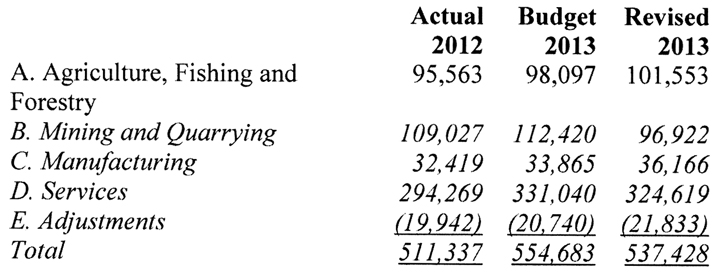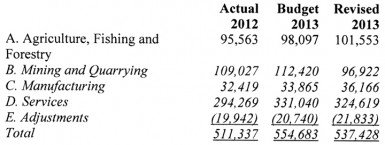Dear Editor,
It was refreshing to see the letter by Chief Statistician Mr. Lennox Benjamin `Challenge of country’s growth estimate was undertaken without single reference to the economy’s sectoral sources of expansion’ (Stabroek News, May 4, 2014). Mr. Benjamin was responding to a letter in the Stabroek News of April 26, 2014 “challeng[ing] the Minister to illustrate to the nation how he arrived at the 5 per cent GDP growth rate reported in his 2014 Budget Speech”. In support of their conclusion “that the 5 per cent growth rate was an act of economic illusion”, the writers of the first letter drew attention to an overall balance of payments deficit of US$119.5 million compared to a surplus of US$32.9 million in 2012.
In his response Mr. Benjamin states that if the writers have doubts on the figures, they must say what the numbers should be. Mr. Benjamin is confusing the duty of the Stats Bureau to produce accurate and timely information with the right of the public to question the information and to ask for explanations. For example, the Stats Bureau reported an inflation rate of 0.9% in 2013, which as Mr. Benjamin knows is not a national inflation rate but an Urban Consumer Price Index for Georgetown only. The so-called inflation rate of 0.9% for 2013 not only defies all logic but is inconsistent with and unsupported by the several different specific and complementary measures and indicators to which Mr. Benjamin himself refers.
Is Mr. Benjamin suggesting that no one must question that 0.9% figure on the grounds that they do not have an actual, scientifically determined number of the real rate of inflation? And would Mr. Benjamin care to explain the 3.5% inflation projected by the IMF Team in December 2013 after consultation with the Stats Bureau and hazard a guess for the decline to 0.9% within days. And would he tell the public whether the Stats Bureau compiles a national inflation index, and if so, what the 2013 index is.
But let us return to the GDP and its 5.2% growth in 2013 applying some of the complementary indicators recommended by Mr. Benjamin to the data provided by the Stats Bureau. Appendix H2 to Volume 1 of the 2014 Estimates is a table of GDP at Current Basic Prices (Rebased). Below is an extract of the sectoral growth reported in that Table, expressed in millions of Guyana Dollars.
In defending the National Accounts produced by the Stats Bureau, Mr. Benjamin assures us that its work and the input data received from sectors in the calculation of the GDP are subject to review and recheck by and submission to several international Agencies. He did not name a single such Agency, or distinguish between those which check and those to which the calculation is sent. Nor did he concede that the quality of the country’s statistics has from time to time been questioned by respected individuals and agencies such as Professor Clive Thomas and the Economist Intelligence Unit.
With respect to the 2013 GDP numbers, he proceeds to give three examples of data on sugar, rice, and mining and quarrying. Data for these sectors are fairly but not completely straight forward to measure. Any errors are likely to understate rather than overstate GDP because of suspected transfer pricing in bauxite, the understatement of gold production and local rice sales. In his haste to debunk the writers, Mr. Benjamin fell into the elementary error of repeating rhetorically that if any one of the sectors or subsectors identified by him was wrong then the total was wrong, completely ignoring the possibility of compensating errors.
The real problem which many persons have with GDP figures is with the Services sector which accounted for 58% of GDP in 2012, increasing to 60% in 2013, a remarkable change by itself. Addressing such concerns requires measured, intelligible explanations, not a polemical and emotional reaction. Services include some really hard-to-measure subsectors such as Transportation and Storage, Education, Construction, Health, and Real Estate Activities.
Specifically, Mr. Benjamin cited the Construction sector in his defence without any apparent awareness that the reported 22.6% growth in the subsector in 2013 includes a substantial correction of an error in the 2012 figures. For that year, the Stats Bureau reported negative growth of 11% even though the imports of cement and steel had increased by more than 25% and local sand output was up 76.5%. Troublingly, the mid-year 2013 year-on-year growth was reported as 6.6%!
Let us take another example: Real Estate Activities at the half-year was 1.2% year-on-year but this grew dramatically to achieve a 5.6% for the full year. Expressed another way, Real Estate Activities are reported to have grown from $5,123 million to $5,482 million, or by 7.01%. Mr. Benjamin is aware that one consequence of real estate activities is a liability to Capital Gains Tax.
What we find however is that Capital Gains Tax collected in 2013 was $265.8 million, down from $408.2 million in 2012, a decline of 34.9%. This is low, even allowing for statutory exemptions and timing differences.
As an aside, the rate of Capital Gains Tax on taxable gains on capital transactions (which include Real Estate) is 20%, compared with the effective rate reported of less than 5%.
In addition to these identified challenges, the Stats Bureau has an item described as Other Service Activities which each year keeps rolling along like the song so that between 2010 and 2013 this unexplained subsector grew by 40%!
I join this exchange because of the importance of national statistics to an enlightened debate and informed action. So rather than deriding those who question the National Income Statistics as having no clue about what goes into the numbers, the Stats Bureau should be doing far more to explain those numbers and to educate the public. It would be instructive for Mr. Benjamin as the Bureau’s Chief Executive Officer, Vice Chairman and Chief Statistician to let the public know about the adequacy of its staff, the level of fieldwork done by the Bureau, the system in place for evaluating reports received and plans for broadening the statistics now produced. On the important matter of the 2012 Census it would be helpful if Mr. Benjamin could tell us when the report will be published and whether the CARICOM Secretariat is in any way responsible for the delay.
In again thanking Mr. Benjamin for responding to concerns about national statistics, I invite him to tell us also about the governance issues in his institution including compliance with the Bureau of Statistics Act.
This Act provides for the appointment and gazetting of a Bureau (Board) comprising not less than five nor more than nine persons and the tabling in the National Assembly of the annual report of the Bureau and the audited financial statements.
Yours faithfully,
Christopher Ram






